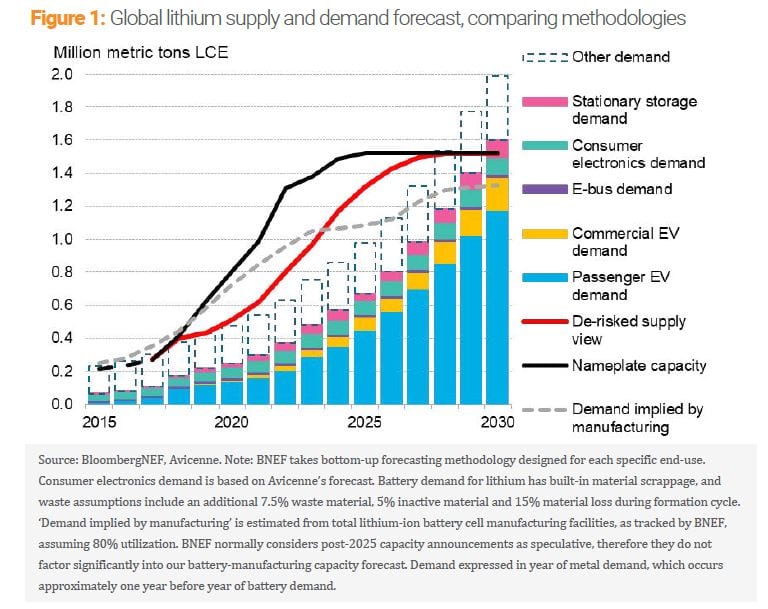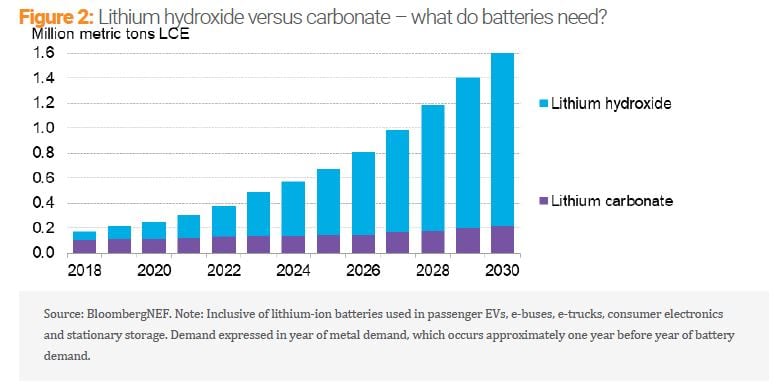Lithium prices have halved since 4Q 2017, driven by perceptions of oversupply in the market and, as a result, major producers are pulling back and re-assessing expansion plans. This boom-bust cycle is not healthy – it breeds more risk and uncertainty for investors. It reemphasizes why it is so important for the lithium industry to get demand forecasting right and grow supply accordingly.
Recently, some companies claim that a slowdown in EV sales in China due to a subsidy cut have resulted in slower growth than anticipated. However, China had been planning the cut to EV subsidies since 2016 and automakers already knew this. The trade war has contributed to a global slowdown in auto sales, which has amplified the slowdown in EVs, but no producer in the EV supply chain should be Recently, some companies claim that a slowdown in EV sales in China due to a subsidy cut have resulted in slower growth than anticipated. However, China had been planning the cut to EV subsidies since 2016 and automakers already knew this. The trade war has contributed to a global slowdown in auto sales, which has amplified the slowdown in EVs, but no producer in the EV supply chain should be So what are the real reasons for the mismatch in expectations for growth between lithium producers and those in the EV market? Part of it may go back to underlying lithium-demand forecasting methodology. The dominant demand consensus amongst lithium producers in early 2018 was that battery demand for lithium chemicals would hit million metric tons lithium carbonate equivalent (LCE) by 2025.
As illustrated by dotted grey-line in Figure 1, this may be true, if forecasting lithium demand is done with a topdown approach, estimating the amount of material needed by battery manufacturers according to how much capacity they are bringing online. However, this assumes that supply aligns with actual demand perfectly. In reality, you have multiple different battery manufacturers that are all expanding capacity to capture the same demand, in a race to gain market share. Therefore, the top-down approach of deriving lithium demand from battery manufacturing capacity has pre-2025 bias to overestimating the industry’s growth.
In contrast, BNEF utilizes detailed bottom-up forecast methodology that reflects the unique growth drivers of each battery-market segment – we do not generalize. We forecast global lithium-ion battery demand will surpass 2,000 GWh by 2030. Key considerations for this bottom-up approach revolve around evolving consumer adoption rates, the changing pack size in vehicles, lithium content in chemistries, and the real-world cell energy densities.

We forecast battery demand for lithium chemicals will reach nearly 700,000 metric tons LCE by 2025. Adding around 300,000 metric tons LCE of non-battery lithium demand means global lithium resource demand could reach the famed “1 million metric tons LCE by 2025”. However, we emphasize that battery demand alone will not reach this target.
This compares to our forecast of 1.3 million metric tons of lithium resource de-risked mine capacity, and 915,000 metric tons of lithium chemical derisked conversion capacity (45% carbonate, 55% hydroxide) by 2025. Although most of this chemical conversion capacity claims to be able to achieve battery-grade quality, we caution that 40% of this capacity is being developed by non-tier 1 producers so face headwinds in achieving quality and volume targets.
Another aspect of lithium-demand forecasts that has not yet achieved market consensus is the split between lithium hydroxide and carbonate. Again, utilizing our bottom-up forecasting, BNEF projects that increasing adoption of higher-nickel cathode chemistries, particularly in passenger EV batteries, will drive demand for lithium hydroxide faster than carbonate. By 2030, demand for battery-grade lithium hydroxide will likely reach nearly 1.4 million metric tons LCE, while carbonate demand will reach 218,000 metric tons LCE in 2030. See Figure 2.

According to the refinery assets currently under development, as tracked by BNEF, there may be an oversupply in lithium carbonate conversion capacity but a deficit of battery-grade lithium hydroxide by 2025. In a worst-case scenario, producers may be able to substitute hydroxide for carbonate in the production of medium nickel chemistries, such as nickel manganese cobalt (622).
Disclaimer
The BloombergNEF (“BNEF”), service/information is derived from selected public sources. Bloomberg Finance L.P. and its affiliates, in providing the service/information, believe that the information it uses comes from reliable sources, but do not guarantee the accuracy or completeness of this information,
which is subject to change without notice, and nothing in this document shall be construed as such a guarantee. The statements in this service/document reflect the current judgment of the authors of the relevant articles or features, and do not necessarily reflect the opinion of Bloomberg Finance L.P., Bloomberg L.P. or any of their affiliates (“Bloomberg”). Bloomberg disclaims any liability arising from use of this document, its contents and/or this service. Nothing herein shall constitute or be construed as an offering of financial instruments or as investment advice or recommendations by Bloomberg of an investment or other strategy (e.g., whether or not to “buy”, “sell”, or “hold” an investment). The information available through this service is not based on consideration of a subscriber’s individual circumstances and should not be considered as information sufficient upon which to base an investment decision. You should determine on your own whether you agree with the content. This service should not be construed as tax or accounting advice or as a service designed to facilitate any subscriber’s compliance with its tax, accounting or other legal obligations. Employees involved in this service may hold positions in the companies mentioned in the services/information The data included in these materials are for illustrative purposes only. The BLOOMBERG TERMINAL service and Bloomberg data products (the “Services”) are owned and distributed by Bloomberg Finance L.P. (“BFLP”) except (i) in Argentina, Australia and certain jurisdictions in the Pacific islands, Bermuda, China, India, Japan, Korea and New Zealand, where Bloomberg L.P. and its subsidiaries (“BLP”) distribute these products, and (ii) in Singapore and the jurisdictions serviced by Bloomberg’s Singapore office, where a subsidiary of BFLP distributes these products. BLP provides BFLP and its subsidiaries with global marketing and operational support and service. Certain features, functions, products and services are available only to sophisticated investors and only where permitted. BFLP, BLP and their affiliates do not guarantee the accuracy of prices or other information in the Services. Nothing in the Services shall constitute or be construed as an offering of financial instruments by BFLP, BLP or their affiliates, or as investment advice or recommendations by BFLP, BLP or their affiliates of an investment strategy or whether or not to “buy”, “sell” or “hold” an investment. Information available via the Services should not be considered as information sufficient upon which to base an investment decision. The following are trademarks and service marks of BFLP, a Delaware limited partnership, or its subsidiaries: BLOOMBERG, BLOOMBERG ANYWHERE, BLOOMBERG MARKETS, BLOOMBERG NEWS, BLOOMBERG PROFESSIONAL, BLOOMBERG TERMINAL and BLOOMBERG.COM. Absence of any trademark or service mark from this list does not waive Bloomberg’s intellectual property rights in that name, mark or logo. All rights reserved. © 2019 Bloomberg












